Ultima Thule: New Horizons explores where no probe has gone before
In 1992, scientists at the Mauna Kea Observatory in Hawaii discovered the first small Kuiper Belt Object (KBO) at the edge of the solar system. Since then, thousands of KBOs have been discovered. Most are ancient “planetesimals,” smaller objects left over from the formation of the solar system. However, a handful, including Pluto, are larger bodies, known as dwarf planets. This third class of planets outnumbers all the terrestrial and giant planets combined, transforming our understanding of the solar system and how it formed.
With this information, NASA accelerated exploring the Pluto system, with an emphasis on mission concepts that could continue past the dwarf planet to explore other KBOs as well. In 2001, NASA selected the Southwest Research Institute-led New Horizons mission to explore the Pluto system and beyond.
New Horizons launched in 2006 and used a 2007 gravity assist from Jupiter to slingshot it toward its primary target — Pluto. Its epic and scientifically remarkable Pluto flyby in the summer of 2015 detailed its dynamic surface and system of moons. Before all the flyby data were downloaded back to Earth, the spacecraft fired its engines to target a small KBO planetesimal a billion miles beyond Pluto called 2014 MU69, now nicknamed Ultima Thule.
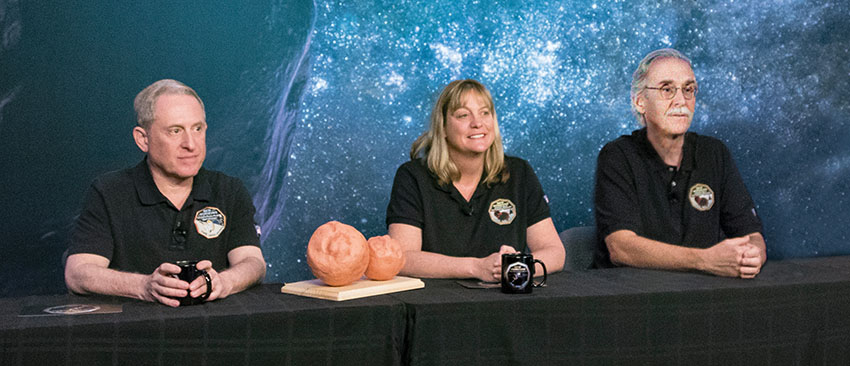
ABOUT THE AUTHORS
Planetary scientist Dr. S. Alan Stern (far left) is the principal investigator of NASA’s New Horizons mission to Pluto and an associate vice president of SwRI’s Space Science and Engineering Division. Dr. Cathy Olkin and Dr. John Spencer are New Horizons coinvestigators and Institute scientists, both specializing in outer solar system bodies.
In ancient literature, Thule is a remote mythical island referenced as the “ends of the Earth.” Ultima Thule means beyond Thule, or beyond the borders of the known world. This moniker truly epitomizes New Horizons’ journey to a distant place never visited before.
TARGETING ULTIMA THULE
The New Horizons team did not find this second flyby target until shortly before the Pluto flyby, and little was known about Ultima Thule until New Horizons arrived. Hubble images and occultation campaigns — looking for a distant star to wink out as the small object passed in front of it — provided only hints about its size, shape and reddish color.
DETAIL
Cold classical KBOs have relatively circular, untilted orbits. They orbit the Sun at a nearly constant distance, never nearing Neptune, so they remain “cool,” unperturbed by the giant planet’s gravity or solar warming.
Ultima Thule was a particularly attractive target because it is one of the so-called cold classical KBOs. These objects originated where they orbit now and so, unlike most KBOs, Ultima Thule has never approached the Sun and warmed. Unlike Pluto, Ultima Thule is too small to have any long-term geologic activity changing its surface. These two facts guarantee that Ultima Thule is probably the most primordial object ever visited, providing the first look at what the original outer solar system bodies were like when they formed. Flying to Ultima Thule was the planetary science equivalent of an archeological dig into the ancient past of our solar system.
In addition to mapping Ultima Thule at high resolution in color and in stereo, we planned to characterize its surface composition, take its temperature and attempt to measure its radar reflectivity. We also planned to search for small moons, which are common among the cold classical KBOs, and look for orbiting dust or rings — however unlikely. We would probe for an atmosphere in case sound scientific reasoning, which indicated an atmosphere should not exist, turned out to be wrong. We even would hunt for evidence of Ultima Thule’s effect on the local solar wind and charged particle environment, even though the physics told us any such effects would probably be undetectable. In effect, we planned to use New Horizons to its fullest capabilities for exploring Ultima Thule.
Contact!
It was another first for New Horizons. Never had such a pristine, primordial object — left over from the birth of the planets — been explored up close. And the results were sensational and sometimes surprising.
Ultima Thule is almost 22 miles long, about 10 times larger than the nucleus of a typical comet and about 1,000 times more massive. Ultima Thule turned out to be a contact binary, two objects that are joined. We dubbed the binary’s two lobes Ultima and Thule, with Ultima being the larger lobe.
The two lobes likely formed in the same individual “collapse cloud” of the ancient solar nebula as a binary, initially resulting in two separate objects orbiting about one another. From the shape of the two lobes of Ultima Thule, we see that the longest dimensions of each lobe are aligned. This implies that as these objects orbited each other, their orbits became tidally locked. The lack of massive fractures or other signs of violence in the two lobes indicates that, over time, their orbit collapsed until the two gently merged. This hypothesis is supported by the similar reflectivities, colors and compositions of the two lobes.
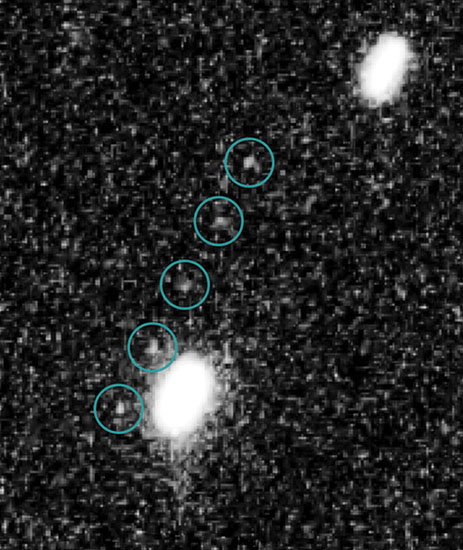
On June 24, 2014, the Hubble Space Telescope discovered New Horizons’ second target, MU69, a distant object too faint to be observed by ground-based telescopes.
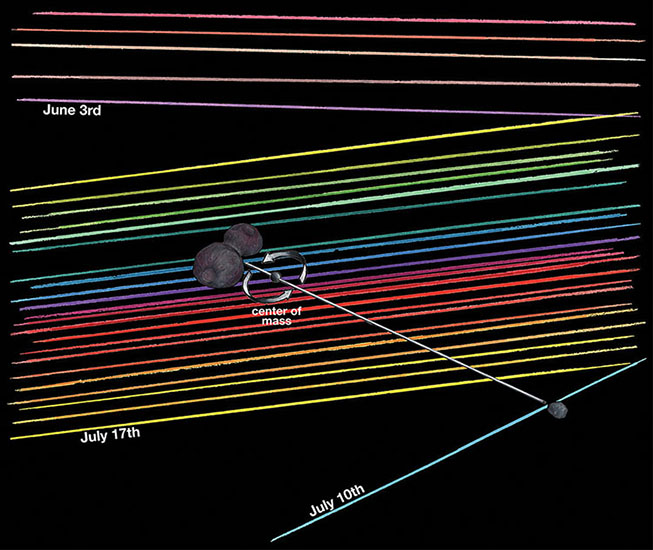
On three occasions in 2017, New Horizons team members tracked Ultima Thule as it passed in front of a star — an event known as an occultation. The colored lines mark the path of the star as seen from different telescopes on each day; blank spaces indicate the few seconds when MU69 blocked the light from the star. We used these observations to accurately predict the shape of Ultima Thule, shown inserted into the blanks in this figure.
However, the contact zone or “neck” between Ultima Thule’s two lobes is covered in brighter material of unknown origin and age. The science team is still debating whether this bright collar was created by the merger itself or evolved later.
Ultima Thule is reddish, like many other KBOs, but high-resolution images revealed patches of significant color variations across its surface. Compositional spectroscopy found evidence for water ice, as expected, and possibly methanol, which could explain its red color. The average surface reflectivity of Ultima Thule is just 7 percent, which is darker than dirt.
The KBO does have remarkably varied terrains across its two lobes. The larger lobe features eight like-sized regions, separated by brighter boundaries. These could represent smaller bodies that fused to form Ultima or perhaps they were created geologically after formation. We also discovered a few probable impact craters, including a large one dominating the smaller, Thule, lobe. Other divots are likely pit crater chains formed by either a sinking or collapse of the surface lying above internal voids.
Because any surface ices volatile enough to sublimate into gases would have long since escaped, Ultima Thule was unlikely to have an atmosphere, which was confirmed by our ultraviolet spectrometer. Many cold classical KBOs have moons, and a few current or escaped KBOs are even known to have rings, but Ultima Thule also turned out to be devoid of satellites and rings.
Perhaps Ultima Thule’s biggest surprise is the curious shapes of its two lobes. Initially, we compared the binary to a snowman. However, one lobe is flatter, more pancake-like than spherical, while the other is shaped a bit like a walnut. Nothing like that has ever been found among KBOs, or anything else orbiting the Sun. In fact, nothing like that had ever been predicted, so formation modelers are already at work, trying to explain this.
QUESTIONS ANSWERED, QUESTIONS SPARKED
What we’ve learned about Ultima Thule so far is shedding light on other KBOs, particularly the cold classical population. For example, the heterogeneous geology of the Ultima lobe tells us that other KBOs may contain clues to how they were assembled and evolved. Maybe Ultima Thule’s moonless skies mean that KBOs that evolve as contact binaries may eject all their satellites in the orbital evolution that brings the two lobes together.
Discovering that Ultima Thule is a contact binary tells us that many KBOs are likely the same, something else that formation modelers will have to resolve. Ultima Thule’s highly tilted spin axis will make that more challenging. Most current models for KBO formation predict uninclined, “up and down” spin axes corresponding with the angular momentum of the solar nebula, the disc-shaped cloud of gas and dust left over from the Sun’s formation.
Meanwhile, Ultima Thule’s crater counts will characterize the small-body KBO population that have impacted it, allowing us to infer size populations much too small for detection with telescopes. Unlike Pluto and some other dwarf planets, Ultima Thule lacks exposed volatile ices like molecular nitrogen, carbon monoxide and methane. This discovery appears to confirm models that indicate small, low-gravity KBOs cannot hold onto the atmospheres that would naturally form when these volatiles outgas.
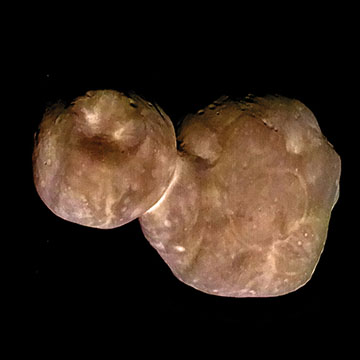
Ultima Thule is very dark red overall, much ruddier than Pluto, with a few brighter areas. This colorized version of a black and white high-resolution image taken by New Horizons integrates hues from its lower-resolution color camera.
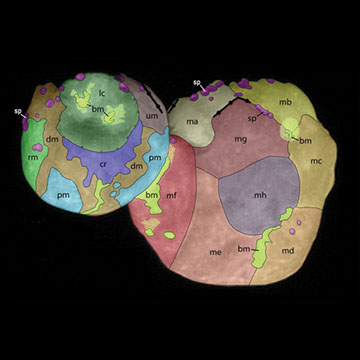
The science team has color-coded various features, including the large crater (labeled lc) on Thule and eight distinct regions on Ultima. These lumpy mounds may be the remaining outlines of the planetesimals that came together to form the larger lobe.
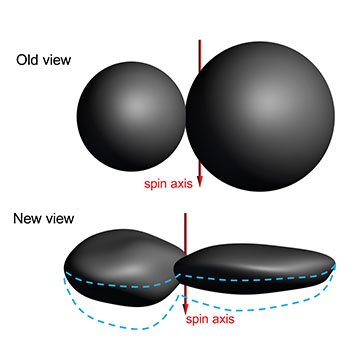
Ultima Thule’s two lobes have a flatter shape than the spherical projection suggested by the flyby’s initial pictures. The dashed blue line marks the remaining uncertainty in the shape of each lobe.
Despite all we learned, New Horizons could not tell us everything about dwarf planets or KBOs. The spacecraft carried a limited payload and many aspects of KBO and dwarf planet science require different instrumentation. New Horizons visited only one of the many dwarf planet systems of the Kuiper Belt and one small KBO thus far. To understand the full range of such objects requires new missions to orbit Pluto and fly by new dwarf planets and small KBOs.
NEXT HORIZONS
Thirteen years and four billion-plus miles later, New Horizons is healthy and operating well, thanks to its designers, builders and flight team. If no serious malfunctions occur, the spacecraft could fly for another 15 years or more — past the edge of the Kuiper Belt — before its power supplies run out. However, New Horizons’ communication capabilities reach far beyond that. Devising lower-power operations could allow more distant explorations.
Currently, New Horizons is funded into 2021. Its tasks include completing the downlink of Ultima Thule flyby data and observing other KBOs from a distance. The spacecraft also will survey the Kuiper Belt’s radiation, solar wind and dust environment to 50 astronomical units (AU), the outer limit of Pluto’s orbit.
DETAIL
An astronomical unit is roughly the distance from the Sun to the Earth, about 93 million miles.
Our science team will soon begin working on a second mission extension proposal to explore the Kuiper Belt’s farther reaches. This proposal focuses on pushing the radiation, dust surveys and long-distance KBO observations out to 60 AU, which is still within the outer limits of the Kuiper Belt as we know it. We hope this mission will include flying by yet another KBO, much farther out than Ultima Thule.
The amount of fuel remaining is the limiting factor for flyby feasibility. Currently, engineers estimate that more fuel than it took to target Ultima Thule will be left for another flyby attempt. After we complete the current phase of intense Ultima Thule science data analyses, the New Horizons team will plot how to find a third, as yet undiscovered target. We will explore using large ground-based telescopes, the Hubble and James Webb space telescopes, and even New Horizon’s onboard camera to find a new flyby target within “fuel reach.”
We don’t know how this will turn out. We must seek before we can find. So, stay tuned for more news about Ultima Thule, as well as the possible discovery of future flyby prospects.
Questions about this article? Contact Catherine Olkin or call +1 303 546 9670.
Sidebar: New Horizons to Explore
So begins the ballad about New Horizons by Dr. Brian May, an astrophysicist better known as the lead guitarist of the rock band Queen. May serves on the New Horizons science team, mostly working on data analysis for stereoscopic imaging.
At the request of mission PI Dr. Alan Stern, he penned, created, and recorded a video for a song about the Ultima Thule flyby, which was released worldwide on New Year’s Eve during the encounter.
“What hit me,” May said, “was how inspiring the whole project was from the point of view of the human spirit of adventure. So that’s really what I wrote this song about, as a tribute to the New Horizons team.”
May was studying astrophysics when Queen rocketed to the top of the charts in the mid-1970s. He left the Ph.D. program to pursue music but returned to Imperial College to earn his doctorate in 2007. He joined the New Horizons team in 2015.
“Brian’s ode to New Horizons touched our entire team,” Stern said, “but even more importantly, it touched millions around the world in a way that few space missions do.”
View May’s music video at: https://youtu.be/j3Jm5POCAj8.

